Exam Details
Exam Code
:JN0-663Exam Name
:Service Provider Routing and Switching, Professional (JNCIP-SP)Certification
:Juniper CertificationsVendor
:JuniperTotal Questions
:96 Q&AsLast Updated
:Mar 25, 2025
Juniper Juniper Certifications JN0-663 Questions & Answers
-
Question 61:
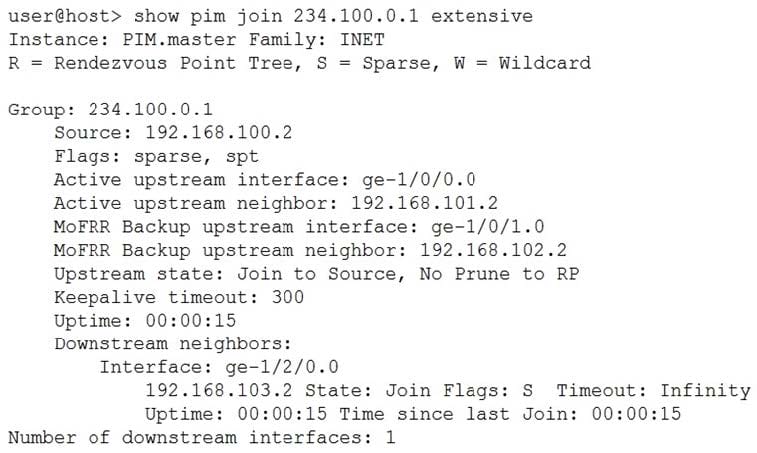
Which three statements are true about the show pim join output shown in the exhibit? (Choose three.)
A. This is a source-specific multicast stream.
B. The multicast receiver is still using the RP to receive the stream.
C. The multicast stream has been configured with a backup path to allow for fast reroute.
D. The multicast stream does not have an RP.
E. The shortest path to the source is through the RP.
-
Question 62:
Why do interprovider option B VPNs scale better than interprovider option A VPNs?
A. The ASBRs in interprovider option B VPNs do not need per-VPN VRF tables.
B. The ASBRs in interprovider option A VPNs do not need per-VPN VRF tables.
C. The ASBRs in interprovider option A VPNs only carry internal routes.
D. The ASBRs in interprovider option B VPNs only carry internal routes.
-
Question 63:
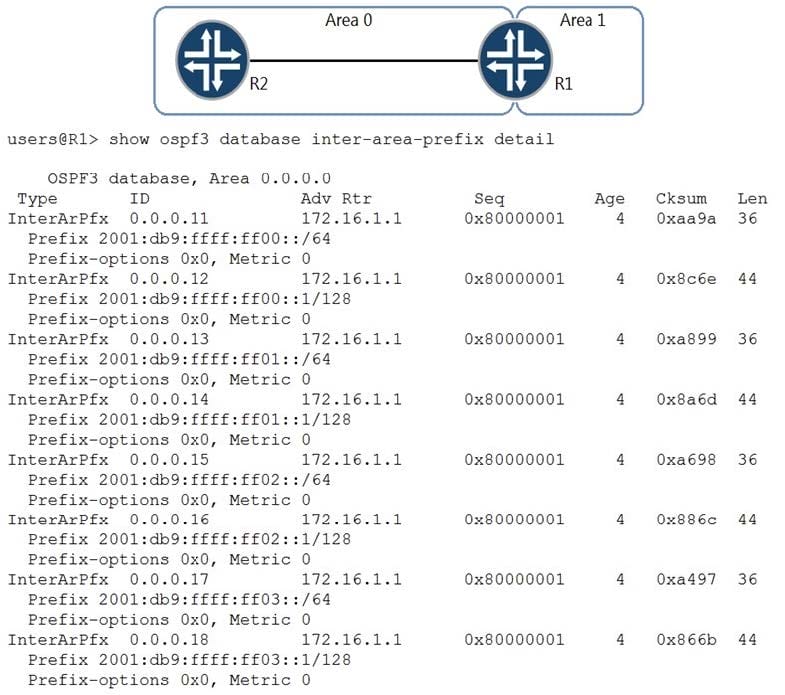
Referring to the exhibit, which command would reduce the size of the OSPF database and corresponding routes?
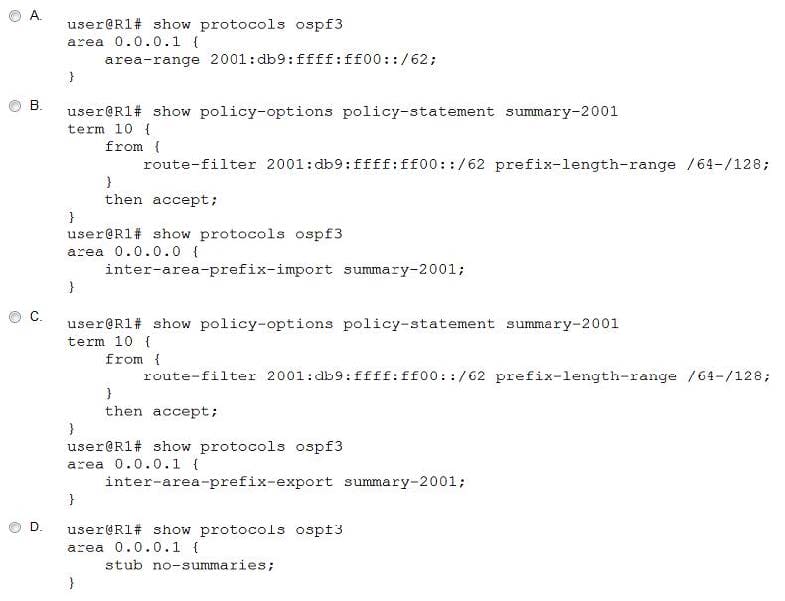
A. Option A
B. Option B
C. Option C
D. Option D
-
Question 64:
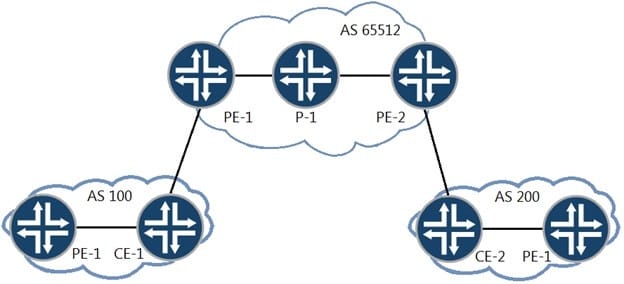
You are providing carrier-of-carrier VPN services for AS 100 and AS 200. You want to distribute MPLS labels between your PE routers and the AS 100 and AS 200 CE routers.
What must be enabled to accomplish this task?
A. Use BGP with the inet-vpn address family enabled.
B. Use BGP with the labeled-unicast address family enabled.
C. Use RSVP with the lsp-set parameter enabled.
D. Use RSVP with the tunnel-services parameter enabled.
-
Question 65:
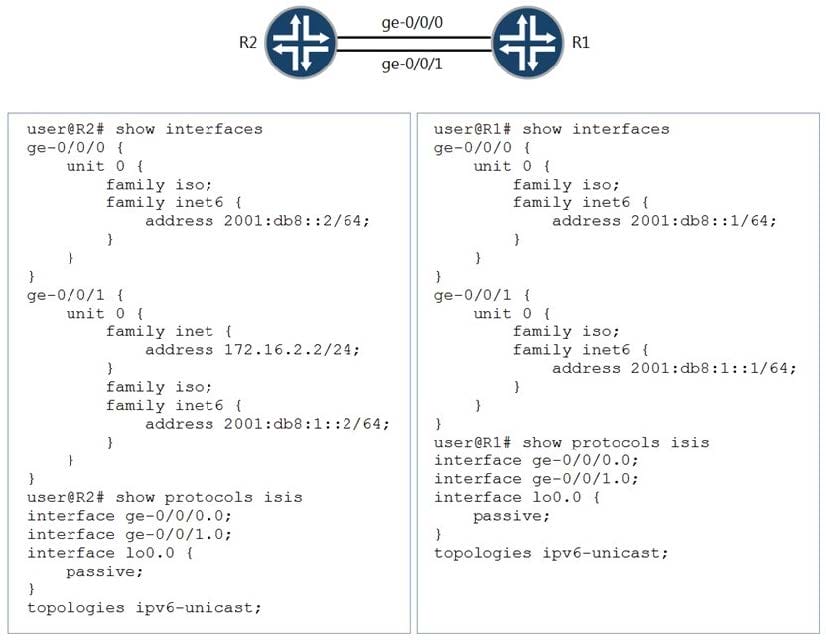
A network administrator is migrating from IPv4 to IPv6 and one of the IS-IS adjacencies is not coming up between R1 and R2.
Which action will solve the problem?
A. Remove topologies ipv6-unicast from protocols isis on R2.
B. Configure topologies ipv4-unicast from protocols isis on R2.
C. Remove topologies ipv6-unicast from protocols isis on R1.
D. Configure an IPv4 address on interface ge-0/0/1 on R1.
-
Question 66:

You have the LDP signaled VPLS topology as shown in the exhibit. CE-B at Site-2 is multihomed to both PE-2 and PE-3.
In this scenario, where would you configure loop prevention?
A. PE-1
B. CE-B
C. PE-3
D. PE-2
-
Question 67:
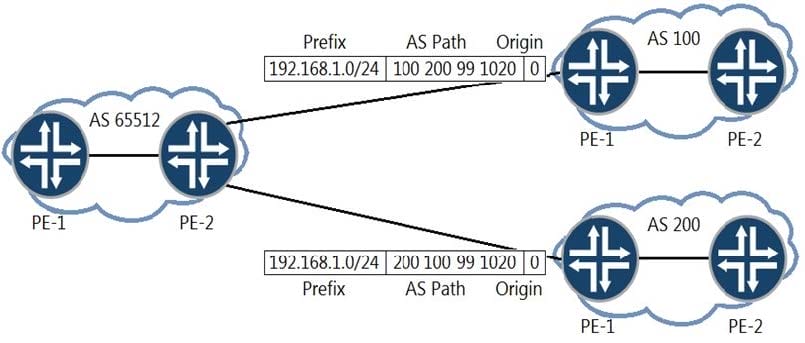
You are the administrator of AS 65512. You are learning the 192.168.1.0/24 prefix from both AS 100 and AS 200. You want traffic destined to the 192.168.1.0.0/24 prefix to exit your AS towards AS 200.
How would you accomplish this task?
A. Configure an import routing policy on PE-2 to set a higher MED on the path learned from AS 100.
B. Configure an import routing policy on PE-2 to modify the origin attribute on the path learned from AS
100.
C. Configure an import routing policy on PE-2 to set a higher local preference value on the path learned from AS 200.
D. Configure an import routing policy on PE-2 to append the AS path attribute on the path learned from AS
100.
-
Question 68:
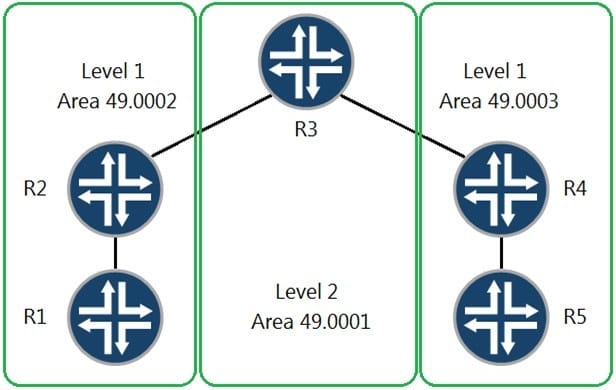
All adjacencies have been formed, no extra options have been configured, and no policies have been written.
Referring to the exhibit, which two statements are correct? (Choose two.)
A. R2 will create a default route and send it as a TLV to R1
B. R1 cannot reach R5
C. R1 can reach R5
D. R1 will create its own default route that points to R2
-
Question 69:
Which two statements are correct about Opaque LSAs in OSPF? (Choose two.)
A. Type 10 LSAs are used for MPLS traffic-engineering and have area scope.
B. Type 11 LSAs are used for MPLS traffic-engineering and have area scope.
C. Type 11 LSAs are used for MPLS label exchange and have link-local scope
D. Type 9 LSAs are used for graceful-restart and have link-local scope
-
Question 70:
The link between CE1 and PE1 has a history of flapping. To avoid the impact that flapping causes to the network, you decide to use route damping.
Which statement is correct in this scenario?
A. Dampening is enabled on interfaces.
B. Dampened routes decay at a sliding rate known as half-life.
C. Routes become dampened when the configured max-suppress value is reached.
D. Dampened routes become active when their figure of merit drops below the reuse value.
Related Exams:
JN0-102
Internet Associate, Junos(JNCIA-Junos)JN0-104
Junos, Associate (JNCIA-Junos)JN0-105
Junos, Associate (JNCIA-Junos)JN0-1101
Juniper Networks Certified Design Associate (JNCDA)JN0-130
Juniper networks Certified internet specialist.e(jncis-e)JN0-1301
Data Center Design, Specialist (JNCDS-DC)JN0-1302
Data Center Design Specialist (JNCDS-DC)JN0-1331
Security Design, Specialist (JNCDS-SEC)JN0-1332
Security Design, Specialist (JNCDS-SEC)JN0-1361
Service Provider Design Specialist (JNCDS-SP)
Tips on How to Prepare for the Exams
Nowadays, the certification exams become more and more important and required by more and more enterprises when applying for a job. But how to prepare for the exam effectively? How to prepare for the exam in a short time with less efforts? How to get a ideal result and how to find the most reliable resources? Here on Vcedump.com, you will find all the answers. Vcedump.com provide not only Juniper exam questions, answers and explanations but also complete assistance on your exam preparation and certification application. If you are confused on your JN0-663 exam preparations and Juniper certification application, do not hesitate to visit our Vcedump.com to find your solutions here.